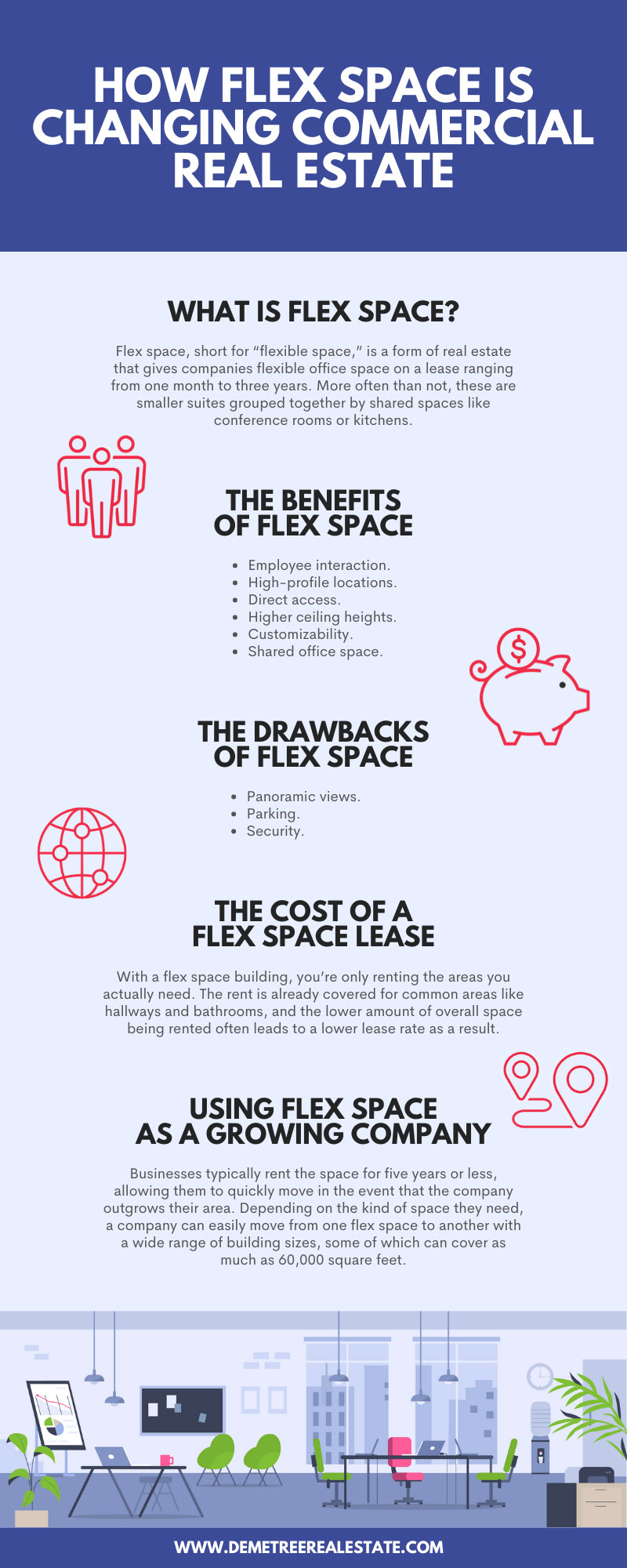 As a company gets started, it takes time to grow into something bigger. At the same time, the company’s owners would still want to be ready for that growth to occur. Fortunately, a new form of real estate has made its way into the market over the last few years: flex space. This gives business owners the opportunity to customize and expand their space however they see fit, allowing them to use the area for any necessity. This is an introduction to the new format and a look at how flex space is changing commercial real estate.
As a company gets started, it takes time to grow into something bigger. At the same time, the company’s owners would still want to be ready for that growth to occur. Fortunately, a new form of real estate has made its way into the market over the last few years: flex space. This gives business owners the opportunity to customize and expand their space however they see fit, allowing them to use the area for any necessity. This is an introduction to the new format and a look at how flex space is changing commercial real estate.
What Is Flex Space?
Flex space, short for “flexible space,” is a form of real estate that gives companies flexible office space on a lease ranging from one month to three years. More often than not, these are smaller suites grouped together by shared spaces like conference rooms or kitchens. They often originate from industrial spaces like warehouses and give the company build-out opportunities to tailor the area to their needs. Typically, flex space provides companies with offices, warehouses, and manufacturing areas all under one roof. Because these areas are located in industrial buildings, they typically only cover the ground floor but still come with ample benefits to growing your business!
The Benefits of Flex Space
Utilizing flex space real estate allows you to take on many opportunities to help grow your business however you want. Below are just a few examples of the benefits:
- Employee interaction. Because the whole space is located on just one floor, you can keep your entire office staff and warehouse personnel under the same roof. This allows them to easily communicate with one another and establish an employee culture, plus you don’t have to cover different leases for multiple spaces!
- High-profile locations. Spaces like these are often found in business parks that not only draw in tenants, but are also very convenient for employees and clients, as the centralized location makes it easy to find and gives employees plenty of places to visit outside of work.
- Direct access. Clients in this scenario don’t have to enter through a loading dock to get to the main office.
- Higher ceiling heights. Whereas the average office’s ceiling is about eight or nine feet high, flex space ceilings typically reach between 12 to 16 feet, but have the capability to reach as high as 24. Not only does this give your warehouse extra shelf space, but it also allows the offices to feel more spacious, creating an environment where noises travel too far to reverberate.
- Customizability. With most offices, your designing abilities are limited by what has already been provided, and it can get particularly expensive to remodel. However, most flex spaces operate as build-to-suit, which enables a tenant to customize their space at a lower cost to fit their needs.
- Shared office space. On many occasions, multiple companies are leasing certain areas of the building at once, leading to them sharing their workspace with one another. Additionally, this comes with the possibility of employees choosing the desk they want to use at the start of the day, although it does mean the area should go through a deep cleaning afterward. This proves cost-effective for everyone as all the companies split the building’s resources (e.g., the receptionist, custodial services, the night cleaning crew, etc.), saving each of them money as a result.
The Drawbacks of Flex Space
Every deal of this nature comes with some sort of downside, although the pros in this case far outweigh the cons when it comes to flex space. These are a couple of disadvantages to using a flex space area:
- Panoramic views. Because flex space buildings are generally one-story, you’re not likely to get that perfect skyline view you often find on higher floors.
- Parking. Most flex space buildings, while equipped with their own parking spaces, don’t come equipped with their own parking garage, which can make it a little trickier in the Florida heat.
- Security. Because of the easy accessibility on the ground floor, there is potential for burglars to look at a flex space building with its laptops and other technology as a “smash and grab” job. Unfortunately, flex spaces don’t have a security guard to monitor the building and prevent these instances from happening, whereas conventional office buildings often do.
The Cost of a Flex Space Lease
One especially important method of how flex space is changing commercial real estate is the way leases work. With a flex space building, you’re only renting the areas you actually need. The rent is already covered for common areas like hallways and bathrooms, and the lower amount of overall space being rented often leads to a lower lease rate as a result. Because rent isn’t being charged for common areas, the usable square footage and rentable square footage are usually the same, with a much smaller gross-up percentage. Usually this amounts to 1 percent as opposed to a typical 15 percent markup factor. For example, if you leased a 5,000-square-foot office space in a traditional office building, you would be paying rent for 5,750 square feet. With flex space leases, you would be paying for about 5,050. They also come with lower realty taxes as a result.
When it comes to Central Florida real estate, the monthly rent for flex space buildings typically falls into the ballpark of roughly one dollar per square foot, sometimes a little more, sometimes much less, although the overall cost depends on the area you’re using. Buildings with a lower lease amount tend to have a noticeably higher square footage.
Using Flex Space as a Growing Company
Flex space buildings are especially beneficial to rapidly growing companies, as leases allow them to plan for any changes that will ultimately be made. Businesses typically rent the space for five years or less, allowing them to quickly move in the event that the company outgrows their area. Depending on the kind of space they need, a company can easily move from one flex space to another with a wide range of building sizes, some of which can cover as much as 60,000 square feet. For companies just getting started or expanding to new possibilities, flex space might be the perfect option for them to take.


Like!! Really appreciate you sharing this blog post.Really thank you! Keep writing.